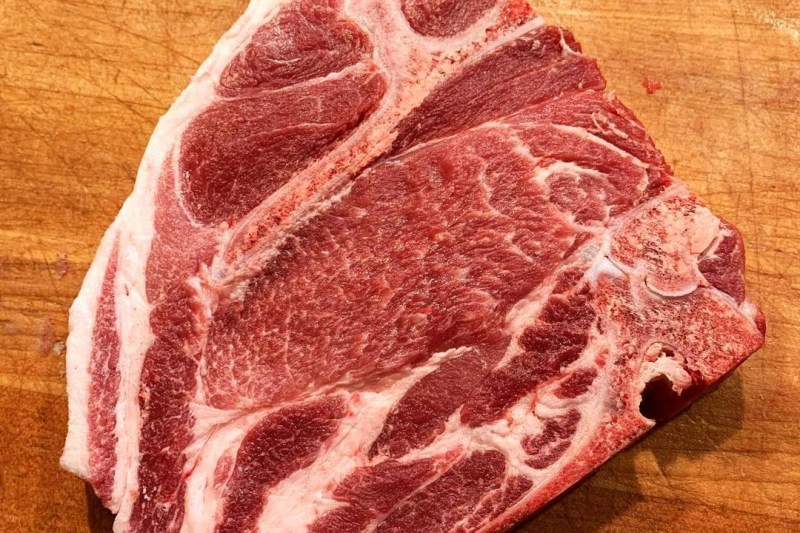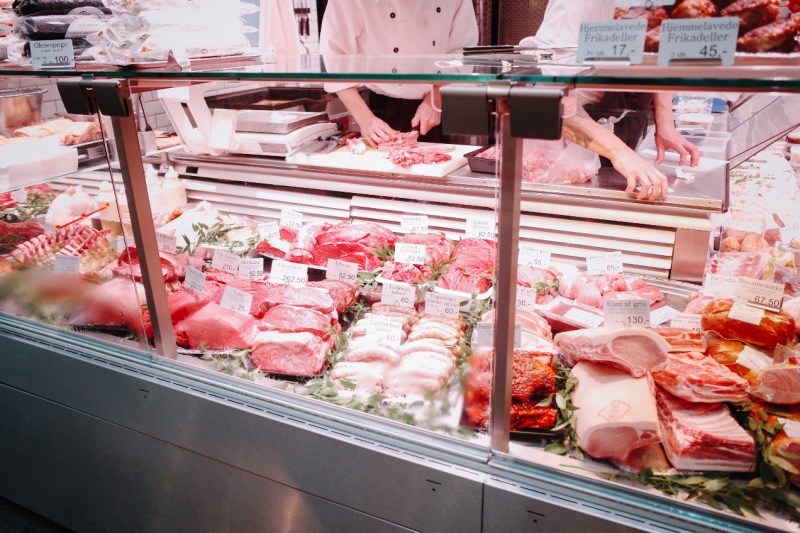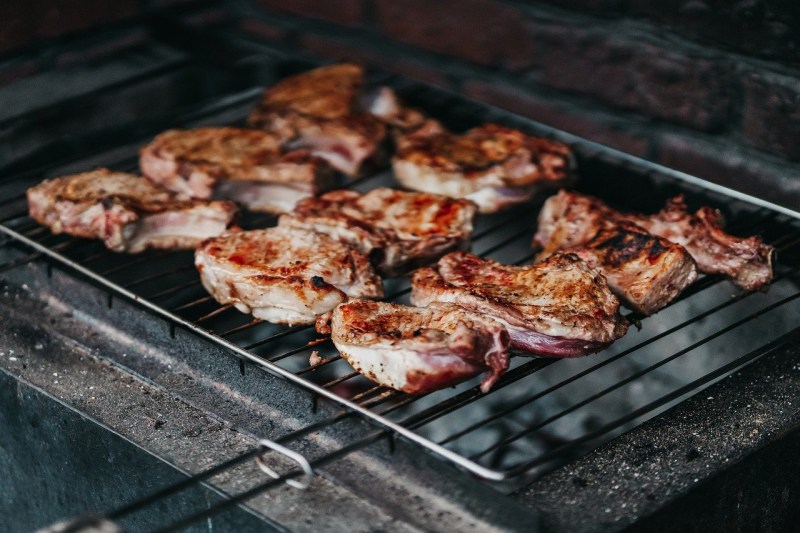When it comes to steaks, I grew up on beef, and beef is by far the most popular choice for searing or grilling in America. But what about pork? While pork chops are popular, and pork ribs are at the top of most BBQ lists, some butcher shops or supermarket meat sections will also have something labeled as pork steaks. These large pieces of pork are intensely flavorful by themselves or with a delicious marinade. It’s a filling and tasty alternative to beef, and once you start trying pork steak dishes, you will wonder where this delicious cut of meat has been your whole life.
What is a pork steak?

First, let’s define the difference between a pork chop and a pork steak. Since pigs and cows are four-legged mammals, pork and beef can be butchered into similar cuts. The key difference is size and fat content since cows are larger and pork is fattier. Pork chops refer to three different parts of the pig — the loin, rib, and sirloin.
The pork loin chop, located underneath the spine of the animal, is commonly butchered with the bone attached (resembling a T-shape). This chop is from the same area as the T-bone or porterhouse steak on a cow. If the loin is deboned and kept whole, this is called a loin roast, one of the most popular pork roasts. The pork rib chop also has a correlation to beef — the ribeye steak. Similar to the ribeye, a pork rib chop has a curved bone attached to the meat with a leaner center and fattier cap. Compared to the loin chop, the rib chop will have more fat and a softer texture. Finally, the sirloin, butchered from the pig’s backend, is a leaner and cheaper cut. Sirloin chops are bigger but tougher than both loin and rib.
So what is a pork steak? Specifically, pork steak is butchered from the pork shoulder (also known as Boston Butt), an area typically used for slow cooking. Adding to the confusion is that this cut is also sold as pork shoulder chops. These are the same thing, the only difference being individual butcher naming preference or the size of the cut. Pork steaks are usually thick and since they are from the pig’s shoulder, have a great balance of fat to meat along with incredible meaty flavor. The downside is that it’s tougher than rib or loin chops. This cut needs some technique and skill to cook properly.
Where to buy pork steaks

Pork steak can sometimes be hard to find because of butchering preferences, customer demand, and different labeling. As mentioned previously, sometimes pork steak is labeled as shoulder chops. If confused by the packaging, the best option is to visit your local butcher and ask for pork steaks.
The butcher will cut a pork shoulder into steaks to your desired thickness. Another option is to order meat online from your favorite purveyor. These companies often source high-quality pork that’s a step above the typical supermarket pork offerings.
How to cook pork steaks

Pork steaks are great marinated. They go extremely well with a spicy marinade of hot peppers and herbs. For something elegant and quick, try a simple blend of lemon juice, garlic, and olive oil. For a Southeast Asian twist, try seasoning your pork steak with lemongrass, garlic, sugar, and fish sauce.
Pork steaks are essentially a blank canvas for flavors and marry well with a diverse range of ingredients. The fatty marbling of pork steaks gives the cut an awesome juiciness. To increase the pork steak’s tenderness, marinate the meat with something acidic like citrus or pineapple juice. This will help break down the meat, making it more tender.
Also, pork steaks will generally include some bones. These bones are not difficult to deal with and effortless to eat around. Because of the thickness, bones, and overall fattiness of pork steaks, they need a longer cooking time than leaner chops like loin. The plus side is that pork steaks are more forgiving because of the excellent marbling, giving you more protection from overcooking.
Great cooking options abound! Pork steaks are often pan-seared, grilled, or even thrown in the oven. If cooking high-quality pork, it’s fine to eat the meat medium to medium rare. But if you’re unsure about pinkish pork or using standard supermarket cuts, cook to an internal temperature of 145 degrees Fahrenheit.
Oven-braised pork steaks (low and slow method)
The oven-braising method is for you if you’re looking for fork-tender pork steaks with deep flavor and minimal fuss. This low and slow cooking technique turns tougher pork shoulder cuts into juicy, fall-apart meat. It’s especially great when you want to skip the grill but still end up with something special.
You start by seasoning your pork steaks with salt, pepper, and any other spices you like, such as paprika, garlic powder, and hot pepper flakes. Sear the steaks in a hot skillet with a little oil just until browned on both sides. This step adds flavor but isn’t strictly necessary if you’re short on time.
Next, place the steaks in a baking dish or Dutch oven. Add aromatics like onion, garlic, and herbs, then pour in your braising liquid — this could be chicken broth, apple cider, beer, or even a splash of white wine. Cover the dish tightly with foil or a lid and bake at 300 degrees Fahreneheit for about 2 to 2.5 hours, or until the meat is tender and easily pulls apart with a fork.
You can serve braised pork steaks straight from the pan with their natural juices, or reduce the braising liquid on the stove to make a flavorful sauce. It’s the kind of meal that tastes like it took all day, even though most of it was hands-off oven time.
Grilling pork steaks
Grilling is one of the most flavorful ways to cook pork steaks, especially if you love a bit of char and smoky intensity. Because pork steaks are cut from the shoulder, they can handle longer cook times over lower heat compared to leaner pork cuts. The key is managing the grill so the fat renders without causing flare-ups.
Bill Head, vice president of Meat & Seafood, says you should make sure you season your pork steaks generously with salt, pepper, or your favorite dry rub or marinade. Preheat your grill to medium heat, and if you’re using charcoal, set up a two-zone fire so you have a direct and indirect heat area. Sear the steaks over direct heat for 2-3 minutes per side to get a nice crust, then move them to indirect heat and cover the grill. Let them cook another 10-15 minutes, flipping occasionally, until they hit an internal temp of 145 degrees Fahrenheit.
You can also baste with barbecue sauce toward the end of cooking for a caramelized finish, but do it late to avoid burning the sugars. Let the steaks rest a few minutes before slicing and serving.
Pan-searing pork steaks
Pan-searing is a great indoor method for cooking pork steaks, especially if you’re only making one or two. The goal here is to get a good crust while rendering some of that rich fat.
Start with room-temperature pork steaks and pat them dry with a paper towel. I’d say go the simple route when seasoning, and use salt, pepper, and any additional spices or herbs you like. Heat a cast-iron or heavy-bottomed skillet over medium-high heat and add a bit of neutral oil. Once hot, lay the pork steak down carefully and don’t move it for a few minutes, as this is what’ll help develop that delicious golden crust.
Sear each side for about 3-4 minutes, then lower the heat to medium or medium-low and continue cooking until the steak reaches an internal temperature of 145 degrees Fahrenheit. If the steak is thick, you can cover the pan loosely with foil or a lid to help it cook through without burning the outside.
For even more flavor, add a chunk of butter and some garlic or rosemary near the end, and spoon the melted butter over the meat. Rest the steak for a few minutes before serving.
Bonus: St. Louis-style pork steak recipe
When you think of the city of St. Louis and pork, you probably think of St. Louis ribs, which are flatter than baby back ribs, and they’re easier to brown on the grill, and then they are covered in a vinegary tomato-based barbecue sauce. But pork steaks are also very popular in St. Louis, and this recipe from Allrecipes shows you how to grill a pork steak St. Louis-style.
Ingredients
- 5 pork shoulder steaks
- 1/8 teaspoon seasoned salt
- 1/8 teaspoon seasoned pepper
- 2 cups apple cider vinegar
- 1 1/2 cups water
Method
- Preheat your grill to medium-low heat and lightly oil the grates.
- Season both sides of the pork steaks with some of the seasoned salt and pepper.
- Add the apple cider vinegar and water to a large bowl and stir in the rest of the seasoned salt and pepper.
- Put the pork steaks on the grill and bake them with the vinegar mixture for the first 15 minutes of cooking.
- After 15 minutes, stop basting and cook the pork steaks for another 10-15 minutes (discard the remaining vinegar mixture).
- The pork steaks are done when an instant-read thermometer reads 145 degrees Fahrenheit.
Best sides to serve with pork steaks

A pork steak is hearty, flavorful, and rich — so pairing it with the right side dish can make or break the meal. You’ll want something that complements the steak’s savoriness or offers a contrast to cut through the richness. Classic barbecue sides are always a hit. Think creamy mac and cheese, tangy coleslaw, baked beans, or grilled corn on the cob. These are tried-and-true comfort food staples that pair especially well with saucy or smoky pork steaks.
For a fresher take, consider a cucumber salad with vinegar dressing or a crunchy apple slaw. The acidity and crispness help balance the fatty marbling of the steak. Roasted or grilled vegetables — like asparagus, Brussels sprouts, or sweet potatoes — add both texture and natural sweetness that round out the plate. If you’re going for Southern-style pork steak, cornbread or skillet-fried potatoes are perfect companions.
On the starchier side of things, mashed potatoes with gravy, cheesy grits, or even a simple baked potato all play well with pork. Want to keep it light? Try a wild rice pilaf or a grain salad with herbs and lemon vinaigrette.
No matter which direction you go — down-home comfort or fresh and bright — a good side dish helps your pork steak shine and keeps the meal feeling complete.




